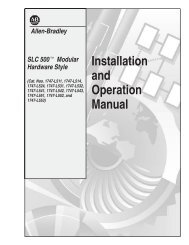1 Overview 2 Details of the Model Construction - Canada France ...
1 Overview 2 Details of the Model Construction - Canada France ...
1 Overview 2 Details of the Model Construction - Canada France ...
You also want an ePaper? Increase the reach of your titles
YUMPU automatically turns print PDFs into web optimized ePapers that Google loves.
dye probe was held near each vent location to visualize <strong>the</strong> entrainment <strong>of</strong> dye towards and into <strong>the</strong><br />
unvented dome model.<br />
8.4 Turbulence Generator Investigation<br />
Robert Breidenthal suggested that if we wished to increase <strong>the</strong> level <strong>of</strong> turbulent layer up to <strong>the</strong> level <strong>of</strong><br />
<strong>the</strong> dome that we could install some turbulence generators upwind <strong>of</strong> <strong>the</strong> dome. In practice this is<br />
unlikely to be feasible, however to give this idea a try we cut a sawtooth shaped turbulence generator<br />
board out <strong>of</strong> corrugated plastic poster-board with teeth 38 mm tall and 19 mm wide at <strong>the</strong> base. This<br />
structure was held on <strong>the</strong> upstream edge <strong>of</strong> <strong>the</strong> model base plate and <strong>the</strong> flow was visualized using dye<br />
probe B6. The depth <strong>of</strong> <strong>the</strong> turbulence generator in <strong>the</strong> water was varied to determine at what point it<br />
had an effect on <strong>the</strong> vortex on <strong>the</strong> upstream side <strong>of</strong> <strong>the</strong> observatory base. The turbulence generator<br />
board is shown in Figure 15.<br />
9 Basic Data Product<br />
The files were saved in <strong>the</strong> AVCHD Lite format <strong>of</strong> <strong>the</strong> Panasonic ZS7 cameras. There were a few<br />
issues around using <strong>the</strong> files in this format. For one, <strong>the</strong> AVCHD format is not commonly supported by<br />
older video display s<strong>of</strong>tware; this is a fairly easy problem to work around. Secondly, we wished to use<br />
MATLAB to automatically process <strong>the</strong> video to determine <strong>the</strong> flushing times in a more quantitative<br />
way, however this video format is not supported by MATLAB. Thirdly, <strong>the</strong> 720p HD format video was<br />
unnecessarily large for most common use and precluded easy distribution on inexpensive data media<br />
(e.g. DVD disks).<br />
The video files were first renamed and organized in a self-explanatory and intuitive path structure that<br />
makes it easy to navigate to <strong>the</strong> video pertaining to a specific experimental configuration. These files<br />
were <strong>the</strong>n converted using <strong>the</strong> SUPER video conversion tool to a AVI format using <strong>the</strong> following<br />
settings:<br />
• Format: AVI<br />
• Output video codec: DivX<br />
• Output audio codec: mp3<br />
• Video scale size: 640 x 360 pixels<br />
• Frame per sec: 14.985 Hz<br />
• Bitrate: 9600 kbps<br />
• Options: Hi-quality<br />
• Audio: 1 Channel, 22050 Hz sampling, 96 kbps bitrate<br />
• MEncoder and DirectShow decode selected (<strong>the</strong> latter only works for <strong>the</strong> Windows OS).<br />
Down-conversion from <strong>the</strong> nominal 60 Hz (30 Hz actual!) frame rate to 15 Hz was necessary to ensure<br />
normal playback speed <strong>of</strong> <strong>the</strong> video. Conversion to <strong>the</strong> actual 30 Hz frame rate <strong>of</strong> <strong>the</strong> video resulted in<br />
video that played back at approximately twice <strong>the</strong> correct speed; this was found for at least 4<br />
conversion packages tried. This problem is related to <strong>the</strong> decoders <strong>of</strong> <strong>the</strong> AVCHD Lite format ignoring<br />
a bit that indicates that each 30 Hz frame should be played twice to achieve <strong>the</strong> nominal 60 Hz<br />
playback.



![Documentation [PDF] - Canada France Hawaii Telescope ...](https://img.yumpu.com/26965302/1/190x245/documentation-pdf-canada-france-hawaii-telescope-.jpg?quality=85)








